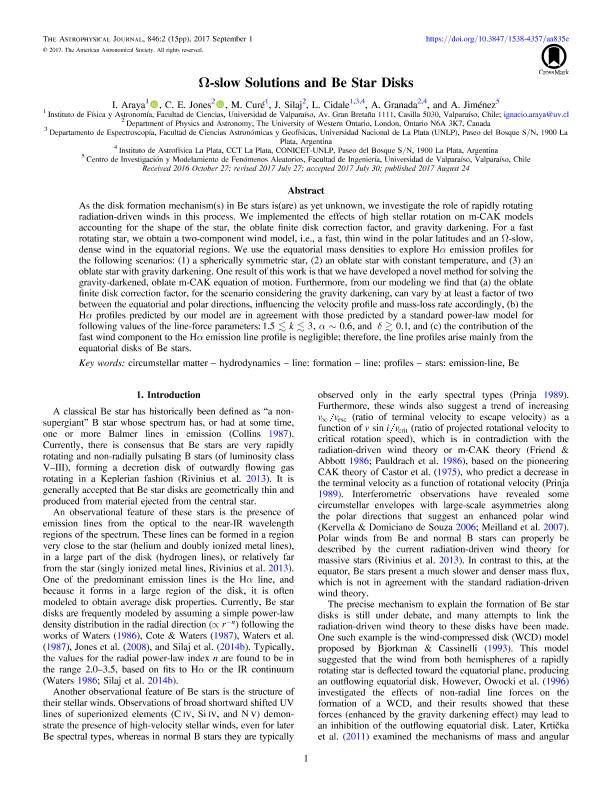Mostrar el registro sencillo del ítem
dc.contributor.author
Araya, I.
dc.contributor.author
Jones, C. E.
dc.contributor.author
Curé, M.
dc.contributor.author
Silaj, J.
dc.contributor.author
Cidale, Lydia Sonia

dc.contributor.author
Granada, A.
dc.contributor.author
Jiménez, A.
dc.date.available
2018-02-07T12:21:51Z
dc.date.issued
2017-09
dc.identifier.citation
Araya, I.; Jones, C. E.; Curé, M.; Silaj, J.; Cidale, Lydia Sonia; et al.; Omega -slow solutions and Be star disks; IOP Publishing; Astrophysical Journal; 846; 9-2017; 1-15
dc.identifier.issn
0004-637X
dc.identifier.uri
http://hdl.handle.net/11336/35922
dc.description.abstract
As the disk formation mechanism(s) in Be stars is(are) as yet unknown, we investigate the role of rapidly rotating radiationdrivenwinds in this process. We implemented the effects of high stellar rotation on m-CAK models accounting for: the shape of the star, the oblate finite disk correction factor, and gravity darkening. For a fast rotating star, we obtain a two-component wind model, i.e., a fast, thin wind in the polar latitudes and an Ω-slow, dense wind in the equatorial regions. We use the equatorialmass densities to explore Hα emission profiles for the following scenarios: 1) a spherically symmetric star, 2) an oblate shaped star with constant temperature, and 3) an oblate star with gravity darkening. One result of this work is that we have developed a novel method for solving the gravity darkened, oblated m-CAK equation of motion. Furthermore, from our modeling we finda) the oblate finite disk correction factor, for the scenario considering the gravity darkening, can vary by at least a factor of two between the equatorial and polar directions, influencing the velocity profile and mass-loss rate accordingly, b) the Hα profiles predicted by our model are in agreement with those predicted by a standard power-law model for following values of the lineforce parameters: 1.5 . k . 3, α ∼ 0.6 and δ & 0.1, and c) the contribution of the fast wind component to the Hα emission line profile is negligible; therefore, the line profiles arise mainly from the equatorial disks of Be stars.
dc.format
application/pdf
dc.language.iso
eng
dc.publisher
IOP Publishing

dc.rights
info:eu-repo/semantics/openAccess
dc.rights.uri
https://creativecommons.org/licenses/by-nc-sa/2.5/ar/
dc.subject
Circumstellar Matter
dc.subject
Winds
dc.subject
Be Stars
dc.subject
Emission Lines
dc.subject
Hydrodynamics
dc.subject
Outflows
dc.subject.classification
Astronomía

dc.subject.classification
Ciencias Físicas

dc.subject.classification
CIENCIAS NATURALES Y EXACTAS

dc.title
Omega -slow solutions and Be star disks
dc.type
info:eu-repo/semantics/article
dc.type
info:ar-repo/semantics/artículo
dc.type
info:eu-repo/semantics/publishedVersion
dc.date.updated
2018-01-12T19:27:35Z
dc.journal.volume
846
dc.journal.pagination
1-15
dc.journal.pais
Estados Unidos

dc.description.fil
Fil: Araya, I.. Universidad de Valparaiso, Chile;
dc.description.fil
Fil: Jones, C. E.. University of Western Ontario; Canadá
dc.description.fil
Fil: Curé, M.. Universidad de Valparaiso, Chile;
dc.description.fil
Fil: Silaj, J.. University of Western Ontario; Canadá
dc.description.fil
Fil: Cidale, Lydia Sonia. Universidad Nacional de la Plata. Facultad de Ciencias Astronómicas y Geofísicas; Argentina. Universidad de Valparaiso, Chile; . Consejo Nacional de Investigaciones Científicas y Técnicas. Centro Científico Tecnológico Conicet - La Plata. Instituto de Astrofísica La Plata. Universidad Nacional de La Plata. Facultad de Ciencias Astronómicas y Geofísicas. Instituto de Astrofísica la Plata; Argentina
dc.description.fil
Fil: Granada, A.. Consejo Nacional de Investigaciones Científicas y Técnicas. Centro Científico Tecnológico Conicet - La Plata. Instituto de Astrofísica La Plata. Universidad Nacional de La Plata. Facultad de Ciencias Astronómicas y Geofísicas. Instituto de Astrofísica la Plata; Argentina. University of Western Ontario; Canadá
dc.description.fil
Fil: Jiménez, A.. Universidad de Valparaiso, Chile;
dc.journal.title
Astrophysical Journal

dc.relation.alternativeid
info:eu-repo/semantics/altIdentifier/url/http://iopscience.iop.org/article/10.3847/1538-4357/aa835e/pdf
dc.relation.alternativeid
info:eu-repo/semantics/altIdentifier/doi/https://doi.org/10.3847/1538-4357/aa835e
Archivos asociados
